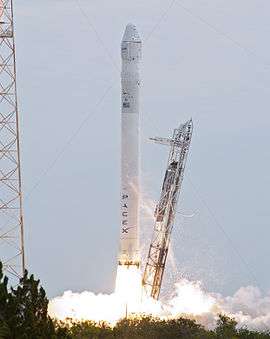Falcon 9 v1.0
 A Falcon 9 v1.0 launches with an uncrewed Dragon spacecraft on a cargo resupply mission to the International Space Station in March 2013, the fifth and final flight of a version 1.0 Falcon 9. | |
| Function | Orbital medium-lift launch vehicle |
|---|---|
| Manufacturer | SpaceX |
| Country of origin | United States |
| Project cost | $ 300 million (including Dragon)[1][2] |
| Cost per launch | $54–59.5 million[3] (2012) |
| Size | |
| Height | 47.8 m (157 ft)[3] |
| Diameter | 3.66 m (12.0 ft) |
| Mass | 333,400 kg (735,000 lb)[3] |
| Stages | 2 |
| Capacity | |
| Payload to LEO | 10,450 kg (23,040 lb)[3] |
| Payload to GTO | 4,540 kg (10,010 lb)[3] |
| Associated rockets | |
| Family | Falcon 9 |
| Derivatives | Falcon 9 v1.1 |
| Launch history | |
| Status | Retired |
| Launch sites | Cape Canaveral SLC-40 |
| Total launches | 5 |
| Successes | 4 |
| Partial failures | 1 (secondary payload only) |
| First flight | June 4, 2010[4] |
| Last flight | March 1, 2013 |
| Notable payloads | Dragon |
| First stage | |
| Engines | 9 Merlin 1C[3] |
| Thrust | 4,940 kN (1,110,000 lbf) |
| Specific impulse |
Sea level: 275 seconds Vacuum: 304 seconds |
| Burn time | 170 seconds |
| Fuel | LOX / RP-1 |
| Second stage | |
| Engines | 1 Merlin 1C vacuum |
| Thrust | 445 kN (100,000 lbf) |
| Specific impulse | 342 s [5] |
| Burn time | 345 seconds |
| Fuel | LOX / RP-1 |
The Falcon 9 v1.0 was the first member of the Falcon 9 launch vehicle family, designed and manufactured by SpaceX in Hawthorne, California. Development of the medium-lift launcher began in 2005, and it first flew in June 2010. The Falcon 9 v1.0 then launched four Dragon cargo spacecraft: one on an orbital test flight, then one demonstration and two operational resupply missions to the International Space Station under a Commercial Resupply Services contract with NASA.
The two stage vehicle was powered by SpaceX's Merlin engines, burning liquid oxygen (LOX) and rocket-grade kerosene (RP-1). It had a payload capacity of 10,450 kg (23,040 lb) to low Earth orbit (LEO) and 4,540 kg (10,000 lb) to geostationary transfer orbit (GTO), though all launches were to LEO.
The vehicle was retired in 2013 and replaced by the upgraded Falcon 9 v1.1, which first flew in September 2013. Of its five launches from 2010-2013, all successfully delivered their primary payload, though an anomaly led to the loss of one secondary payload.
Design
First stage


The Falcon 9 v1.0 first stage was used on the first five Falcon 9 launches, and powered by nine SpaceX Merlin 1C rocket engines arranged in a 3x3 pattern. Each of these engines had a sea-level thrust of 556 kilonewtons (125,000 lbf) for a total thrust on liftoff of about 5,000 kilonewtons (1,100,000 lbf).[6]
The Falcon 9 tank walls and domes were made from aluminum lithium alloy. SpaceX uses an all-friction stir welded tank, the highest strength and most reliable welding technique available.[6]
The Falcon 9 v1.0 first stage used a pyrophoric mixture of triethylaluminum-triethylborane (TEA-TEB) as a first-stage ignitor.[7]
Second stage
The upper stage was powered by a single Merlin 1C engine modified for vacuum operation, with an expansion ratio of 117:1 and a nominal burn time of 345 seconds. For added reliability of restart, the engine has dual redundant pyrophoric igniters (TEA-TEB).[6]
The Falcon 9 v1.1 interstage, which connects the upper and lower stage for Falcon 9, is a carbon fiber aluminum core composite structure. Reusable separation collets and a pneumatic pusher system separate the stages. The stage separation system had twelve attachment points (later reduced to just three in the v1.1 launcher).[8]
The second stage tank of Falcon 9 is simply a shorter version of the first stage tank and uses most of the same tooling, material and manufacturing techniques. This saves money during vehicle production.[6]
Four Draco thrusters were used on the Falcon 9 v1.0 second-stage as a reaction control system.[9] The thrusters were used to hold a stable attitude for payload separation or, as a non-standard service, were also designed to be used to spin up the stage and payload to a maximum of 5 rotations per minute (RPM),[9] although none of the five flown missions had a payload requirement for this service.
Control
SpaceX uses multiple redundant flight computers in a fault-tolerant design. Each Merlin engine is controlled by three voting computers, each of which has two physical processors that constantly check each other. The software runs on Linux and is written in C++.
For flexibility, commercial off-the-shelf parts and system-wide "radiation-tolerant" design are used instead of rad-hardened parts.[10]
Development and production

Funding
While SpaceX spent its own money to develop its first launch vehicle, the Falcon 1, the development of the Falcon 9 was accelerated by the purchase of several demonstration flights by NASA. This started with seed money from the Commercial Orbital Transportation Services (COTS) program in 2006.[11] SpaceX was selected from more than twenty companies that submitted COTS proposals.[12] Without the NASA money, development would have taken longer, Musk said.[2]
The development costs for Falcon 9 v1.0 were approximately US$300 million, and NASA verified those costs. If some of the Falcon 1 development costs were included, since F1 development did contribute to Falcon 9 to some extent, then the total might be considered as high as US$390 million.[13] [2]
NASA also evaluated Falcon 9 development costs using the NASA‐Air Force Cost Model (NAFCOM)—a traditional cost-plus contract approach for US civilian and military space procurement—at US$$3.6 billion based on a NASA environment/culture, or US$$1.6 billion using a more commercial approach.[14][13]
Production
In December 2010, the SpaceX production line was manufacturing one new Falcon 9 (and Dragon spacecraft) every three months, with a plan to double the production rate to one every six weeks in 2012.[15]
Reusability testing
SpaceX ran a limited set of post-mission booster recovery flight tests on the early Falcon rocket launches, both Falcon 1 and Falcon 9. The initial parachute-based design approach was ultimately unsuccessful, and the company adopted a new propulsive-return design methodology that would utilize the Falcon 9 v1.1 vehicle for orbital recovery testing, but did use a Falcon 9 v1.0 booster tank for low-altitude low-velocity flight testing in 2012–2013.
From early days in the development of the Falcon 9, SpaceX had expressed hopes that both stages would eventually be reusable. The initial SpaceX design for stage reusability included adding lightweight thermal protection system (TPS) capability to the booster stage and utilizing parachute recovery of the separated stage. However, early test results were not successful,[16] leading to abandonment of that approach and the initiation of a new design.
In 2011 SpaceX began a formal and funded development program—the SpaceX reusable launch system development program—with the objective of designing reusable first and second stages utilizing propulsive return of the stages to the launch pad. The early program focus, however, is only on return of the first stage.[17]
As an early component of that multi-year program, a Falcon 9 v1.0 first stage tank, 32 metres (106 ft) long, was used to build and test the Grasshopper prototype test vehicle, which made eight successful low-altitude takeoffs and vertical landings in 2012–2013 before the vehicle was retired.
Launch history
The v1.0 version of Falcon 9 was launched five times, all successfully carrying a Dragon spacecraft to low-Earth orbit, of which three achieved docking with the International Space Station. One of those missions deployed its secondary payload in a lower orbit than expected due to an engine failure and safety constraints imposed by the ISS primary mission.
See also
References
- ↑ Press Release Source: SpaceX (May 4, 2011). "Why the US Can Beat China: The Facts About SpaceX Costs". spaceref.com. Retrieved 18 February 2015.
- 1 2 3 "The Facts about SpaceX Costs". spacex.com. May 4, 2011.
- 1 2 3 4 5 6 "Falcon 9". SpaceX. Archived from the original on 23 March 2012. Retrieved 28 September 2013.
- ↑ "Detailed Mission Data – Falcon-9 ELV First Flight Demonstration". Mission Set Database. NASA GSFC. Retrieved 2010-05-26.
- ↑ "SpaceX Falcon 9 Upper Stage Engine Successfully Completes Full Mission Duration Firing" (Press release). SpaceX. March 10, 2009.
- 1 2 3 4 "Falcon 9 Overview". SpaceX. 8 May 2010.
- ↑ Mission Status Center, June 2, 2010, 1905 GMT, SpaceflightNow, accessed 2010-06-02, Quotation: "The flanges will link the rocket with ground storage tanks containing liquid oxygen, kerosene fuel, helium, gaseous nitrogen and the first stage ignitor source called triethylaluminum-triethylborane, better known as TEA-TEB."
- ↑ Klotz, Irene (2013-09-06). "Musk Says SpaceX Being "Extremely Paranoid" as It Readies for Falcon 9's California Debut". Space News. Retrieved 2013-09-13.
- 1 2 "Falcon 9 Launch Vehicle Payload User's Guide, 2009" (PDF). SpaceX. 2009. Retrieved 2010-02-03.
- ↑ Svitak, Amy (2012-11-18). "Dragon's "Radiation-Tolerant" Design". Aviation Week. Retrieved 2012-11-22.
- ↑ Mr. Alan Lindenmoyer, Manager, NASA Commercial Crew & Cargo Program, quoted in Minutes of the NAC Commercial Space Committee, April 26, 2010
- ↑ "Private ventures vie to service space station". MSNBC. 2006-03-20. Retrieved 2013-12-02.
- 1 2 "Commercial Market Assessment for Crew and Cargo Systems" (pdf). nasa.gov. NASA. 2011-04-27. p. 40. Retrieved 10 June 2015.
SpaceX has publicly indicated that the development cost for Falcon 9 launch vehicle was approximately $300 million. Additionally, approximately $90 million was spent developing the Falcon 1 launch vehicle which did contribute to some extent to the Falcon 9, for a total of $390 million. NASA has verified these costs.
- ↑ "Falcon 9 Launch Vehicle NAFCOM Cost Estimates" (PDF). NASA. August 2011. Retrieved 2013-12-02.
- ↑ Chow, Denise (2010-12-08). "Q & A with SpaceX CEO Elon Musk: Master of Private Space Dragons". space.com. Retrieved 2013-12-02.
now have Falcon 9 and Dragon in steady production at approximately one F9/Dragon every three months. The F9 production rate doubles to one every six weeks in 2012.
- ↑ "Musk ambition: SpaceX aim for fully reusable Falcon 9". NASAspaceflight.com. 2009-01-12. Retrieved 2013-05-09.
With Falcon I’s fourth launch, the first stage got cooked, so we’re going to beef up the Thermal Protection System (TPS). By flight six we think it’s highly likely we’ll recover the first stage, and when we get it back we’ll see what survived through re-entry, and what got fried, and carry on with the process. That’s just to make the first stage reusable, it’ll be even harder with the second stage – which has got to have a full heatshield, it’ll have to have deorbit propulsion and communication.
- ↑ Simberg, Rand (2012-02-08). "Elon Musk on SpaceX's Reusable Rocket Plans". Popular Mechanics. Retrieved 2013-03-08.